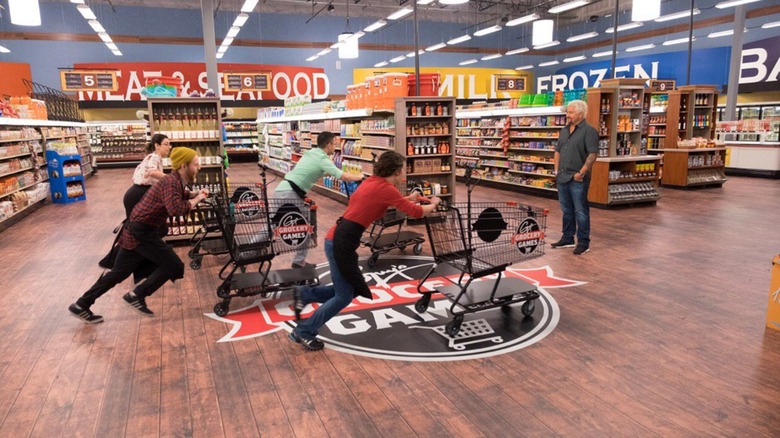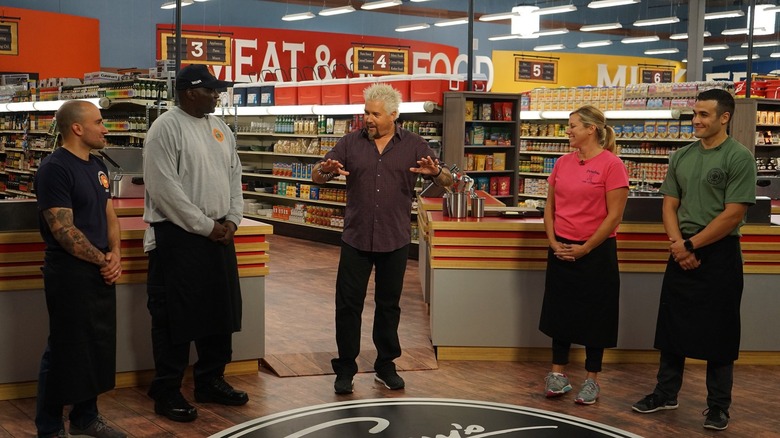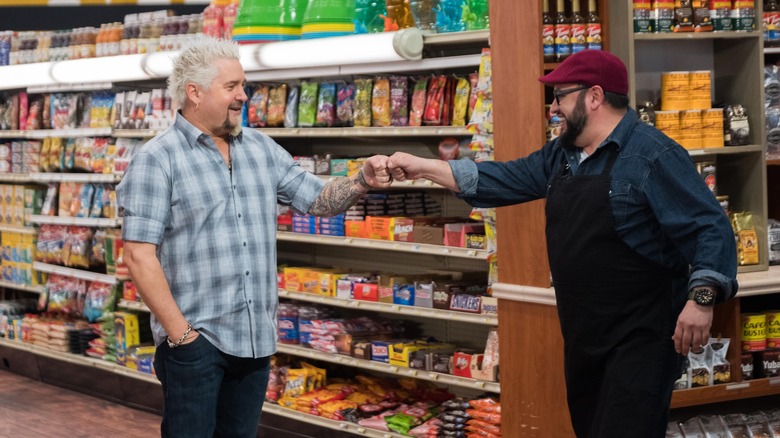Guy's Grocery Game's Flavortown Market Is Kind Of A Real Store
Chef Guy Fieri is behind a slew of popular cooking shows, both past and present. From the long-running "Diners, Drive-Ins, and Dives," currently in its 37th season, to the "Tournament of Champions" and the nostalgic "Triple D Nation" – Fieri is just as much an expert in TV as he is about food. Another one of Fieri's biggest productions, "Guy's Grocery Games," also boasts a long list of successful episodes – season 32 is airing now. What sets this show apart from others is that contestants actually collect their ingredients from a makeshift grocery store before crafting dishes.
With thousands of products sitting on the shelves for just four chefs every show, some viewers might wonder – what happens to the leftover food that isn't used? Well, you might be surprised to know the Flavortown Market of "Guy's Grocery Games" is kind of a real store — and they do things a little differently than other shows.
How the Flavortown Market come to be
Loyal fans of "Guy's Grocery Games" might remember that the set from the first season looked a lot different than the one used in more recent episodes. That's because Season 1 of the show was actually filmed in a real-life supermarket before Fieri decided to make a switch. The program first began filming at a store called Fields Market in California, which boasted a selection of over 25,000 unique products but then decided to move its operations to a 15,500-square-foot warehouse in Santa Rosa for Season 2.
It only took contractors two weeks to turn the space into a supermarket, a process that normally takes up to two years. With the capacity to hold up to 20,000 products, the Flavortown Market was officially born in 2014. Turns out, filming at an original location gave producers more control over the show, space, and products. Aisles at the Flavortown Market are wider than normal, so contestants have more room to speed shop, and the lighting is brighter, so chefs have an easier time seeing the products. The Flavortown Market is also stocked with products from local expert purveyors.
While the aisles, checkout lanes, and freezers are real, the store is still built in a warehouse, and the walls are simply painted plywood panels. False walls aside, the store itself is fully operational.
How the iconic shop operates
While it's easy for regular TV shows and films to trick viewers into thinking artificial sets are real, Guy Fieri took things a step further with "Guy's Grocery Games." Contestants shop for ingredients for their dishes, so the products have to be real, and they have to be in stock. But with all that fresh food and only a few contestants perusing the shelves each season, one might think a lot of food goes to waste. Luckily, that's not the case.
Complete with an array of dairy products, fish, meat, 241 kinds of produce, a bakery, and much more, an entire staff keeps the 20,000 items stocked and on the shelves. Each week, stockers examine the produce and meats and replenish them for freshness. This usually happens every Monday right before the competition begins, so stockers have three hours to replenish anything the contestants previously used from the show before. To extend shelf life, the meat for the Flavortown Market comes vacuum sealed, and the seafood orders arrive on a Saturday or Sunday right before the competition. Finally, on Friday, any food nearing its expiration date is given to food banks.
While the Flavortown Market is fully operational, it still primarily serves as a TV set and is not open to the public. So, if you want to experience it for yourself, talk to casting.


